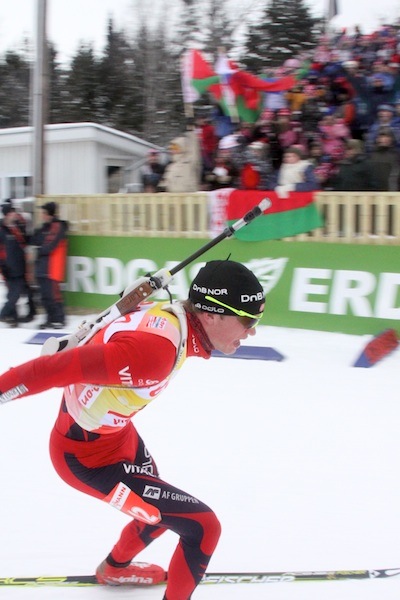
With seven months to go until the IBU World Cup arrives in Canmore, Alberta, and then travels to Presque Isle, Maine, international biathlon stars are already considering whether to skip the events.
“I wish the races were in Europe,” Norway’s Emil Hegle Svendsen told broadcaster NRK.
Roughly every five years, the World Cup travels to North America. The last time was in 2011, when the tour stopped in Presque Isle and nearby Fort Kent. At those races, most of the top stars vying for the overall World Cup title attended, but many of the others in the top 20 or 30 skipped the races. Field sizes were considerably smaller than for other World Cups.
The Norwegians’ main concern seems to be that the North American period of racing falls directly before World Championships, and they would rather prepare at home: Oslo is hosting the 2016 edition. At the very least, they would like to be in the right time zone.
“I hate that it’s set up like this,” Tarjei Bø, the most successful male athlete at the 2015 World Championships in Kontiolahti, Finland, told NRK.
“This is a headache for us all,” agreed his coach, Egil Gjelland.
But Max Cobb, the head of the IBU’s Technical Committee, which sets the World Cup Schedule, said in an interview that the committee had carefully considered whether there would be enough time for athletes to adjust back to being in Europe and prepare for the Oslo Championships.
After all, it’s not like athletes will fly directly to Oslo after Maine and start racing the next day.
“We looked at trying to maximize the amount of time between the North American World Cups and the World Championships,” Cobb said on Tuesday. “I think there’s two and a half weeks there, and that was a reasonable amount of time for preparation. If it had been a week less than that, then there would be a lot of teams considering not attending, or not sending their best athletes.”
In addition, he suggested that teams might even maximize that time by managing their rosters. For instance, the weekend competitions in Presque Isle are relays; teams could race their “B” squads in the relays, and send their “A” teams back to Norway or another home training base.
The first competition of World Championships is always a mixed relay, raced by only two men and two women from each country. That provides the rest of the athletes with even more time to train, adjust, and prepare.
“We felt like it was important to put Canmore first, so that teams could decide when to arrive in North America based on jetlag and altitude training and those kinds of things,” Cobb said of the scheduling decisions. “And Calgary being an international air hub, that they could choose exactly when they wanted to arrive with lots of direct flights from Europe. Do that, and then come back to Presque Isle two hours closer to Europe, and fly home from there.”
IBU President Anders Besseberg, himself a Norwegian, also wasn’t pleased with the threat of a boycott by the top Norwegians.
“The US and Canada have many good athletes who have to travel to Europe to compete here, and then I think it gets a little petty if one boycotts the races over there, so to speak,” he told NRK. “I think it is stupid if Norway does not compete with some of their best athletes.”
Cobb was slightly surprised to hear the criticism coming from the Norwegians, since he believed he had adequately addressed the situation with team staff when the schedule was set.
“I had some discussions with a couple of Norwegian coaches around the World Championships this year, and it sounded like they were reassured once they realized that there was in fact two and a half weeks,” he explained.
Still, the Norwegian men’s team made it clear that World Championship medals were the most important thing to them, and they’d consider staying at home in Europe for well over a month in preparation if that’s what it took.
“It is not often the United States has a World Cup, and then when you put it right before the World Championships it goes without saying that not everyone is going to go over there,” Johannes Thingnes Bø concluded.
Chelsea Little
Chelsea Little is FasterSkier's Editor-At-Large. A former racer at Ford Sayre, Dartmouth College and the Craftsbury Green Racing Project, she is a PhD candidate in aquatic ecology in the @Altermatt_lab at Eawag, the Swiss Federal Institute of Aquatic Science and Technology in Zurich, Switzerland. You can follow her on twitter @ChelskiLittle.



